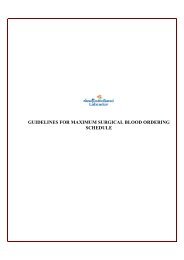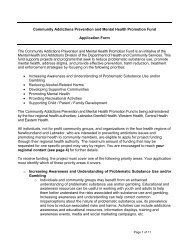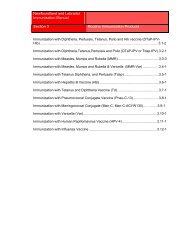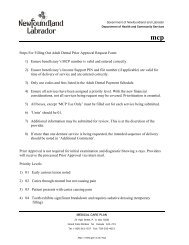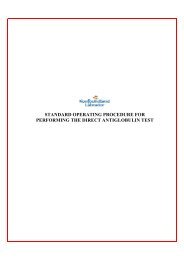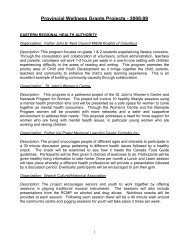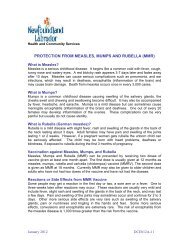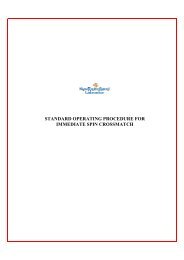standard operating procedure for immediate spin crossmatch
standard operating procedure for immediate spin crossmatch
standard operating procedure for immediate spin crossmatch
You also want an ePaper? Increase the reach of your titles
YUMPU automatically turns print PDFs into web optimized ePapers that Google loves.
STANDARD OPERATING PROCEDURE FORIMMEDIATE SPIN CROSSMATCH
Provincial BloodCoordinating ProgramStandard Operating Procedure <strong>for</strong>Immediate Spin CrossmatchTITLE: STANDARD OPERATING PROCEDURE FORIMMEDIATE SPIN CROSSMATCH1.0 PrincipleTo demonstrate ABO compatibility between donor red cells and recipient’splasma/serum when the antibody screen is negative and there is no previoushistory of clinically significant antibodies.2.0 Scope and Related Policies2.1 Be<strong>for</strong>e red cells are transfused, compatibility testing must be per<strong>for</strong>med,Incompatible or un<strong>crossmatch</strong>ed donor units should only be transfused whena clinical situation justifies an exception. Any exception shall be approvedby the medical director or his or her designate. Authorization must bedocumented according to facility <strong>procedure</strong>.2.2 When the antibody screen indicates the presence of a clinically significantred cell antibody or the recipient has a previous history of clinicallysignificant antibodies, the red cells shall be <strong>crossmatch</strong>ed using anantiglobulin technique.2.2.1 If the method used <strong>for</strong> the AHG <strong>crossmatch</strong> is unable to detectABO incompatibility then an <strong>immediate</strong> <strong>spin</strong> <strong>crossmatch</strong> must beper<strong>for</strong>med as well.2.3 For recipients that may need additional units, the original blood specimenmay be used <strong>for</strong> <strong>crossmatch</strong> within the 96 hour period post transfusion of thefirst unit of blood.2.4 The ABO type of the red cells collected and prepared by the blood suppliermust be confirmed if a serological <strong>crossmatch</strong> is not per<strong>for</strong>med be<strong>for</strong>etransfusion of the red cells._______________________________________________________________________This document may be incorporated into each Regional Policy/Procedure Manual.NL2011.018Version: 1.0Effective Date: 2011-07-15Page 2 of 9
Provincial BloodCoordinating ProgramStandard Operating Procedure <strong>for</strong>Immediate Spin Crossmatch3.0 Specimens3.1 EDTA anticoagulated whole blood3.2 Serum (Do not use samples drawn into tubes with neutral gel separators)4.0 MaterialsReagents:Isotonic salineSupplies:Test tubes (10x75mm)Transfer pipettesTest tube rackEquipment:Serological centrifugeDonor Unit (s)5.0 Quality Control5.1 Any ABO discrepancy shall be resolved and the resolution documentedbe<strong>for</strong>e issuing red cells.5.2 Quality control of blood components and equipment shall be retained <strong>for</strong>five years._______________________________________________________________________This document may be incorporated into each Regional Policy/Procedure Manual.NL2011.018Version: 1.0Effective Date: 2011-07-15Page 3 of 9
Provincial BloodCoordinating ProgramStandard Operating Procedure <strong>for</strong>Immediate Spin Crossmatch6.0 Process Flowchart6.1 Process Flow_______________________________________________________________________This document may be incorporated into each Regional Policy/Procedure Manual.NL2011.018Version: 1.0Effective Date: 2011-07-15Page 4 of 9
Provincial BloodCoordinating ProgramStandard Operating Procedure <strong>for</strong>Immediate Spin Crossmatch7.0 Procedure7.1 Determine specimen suitability. (See NL2010.012 Determining SpecimenSuitability).7.2 Centrifuge specimen. (Speed and time as recommended by manufacturer’sdirections).7.3 Check specimen after centrifuging (e.g.hemolysis). (See NL2010.012Determining Specimen Suitability).7.4 Per<strong>for</strong>m a patient history check. (See NL2010-013 Patient History Check).7.4.1 If the patient has a history of clinically significant antibodiesper<strong>for</strong>m an AHG <strong>crossmatch</strong>. If the method used to per<strong>for</strong>m anAHG <strong>crossmatch</strong> does not detect ABO incompatibility, per<strong>for</strong>m anIS <strong>crossmatch</strong> as well.7.5 Ensure patient in<strong>for</strong>mation on the sample corresponds with the patientin<strong>for</strong>mation on the worksheet.7.6 Select the appropriate donor unit from the blood bank refrigerator.7.7 Visually inspect each donor unit.7.8 Record the donor unit number on the patient’s worksheet.7.9 Label 2 tubes with a donor number label from the donor bag (if the donornumber label is not available, label with at least the last 4 digits from thedonor unit number) <strong>for</strong> each red cell unit to be <strong>crossmatch</strong>ed. One tube willbe used <strong>for</strong> preparing the donor cell suspension and the other will be the<strong>crossmatch</strong> tube.7.10 Detach one donor segment from the unit, cut and express contents inappropriate labelled tube. Return the donor unit (s) to the blood bankrefrigerator.7.11 Wash the donor cells once with isotonic saline and make a 3-5% cellsuspension._______________________________________________________________________This document may be incorporated into each Regional Policy/Procedure Manual.NL2011.018Version: 1.0Effective Date: 2011-07-15Page 5 of 9
Provincial BloodCoordinating ProgramStandard Operating Procedure <strong>for</strong>Immediate Spin Crossmatch7.12 Add the following to each labelled <strong>crossmatch</strong> tube:• 2 drops of patient’s plasma or serum• 1 drop of the donor cell suspension7.13 Mix the contents of each tube.7.14 Centrifuge tubes. (Speed and time as recommended by manufacturer’sdirections).7.15 Examine <strong>for</strong> hemolysis. Record if present.7.16 Immediately resuspend the cells by gentle agitation; examine the tubesmacroscopically <strong>for</strong> agglutination.7.17 Grade and record results.7.18 Prepare a <strong>crossmatch</strong>/transfusion card with at least the followingin<strong>for</strong>mation:• Recipient’s name• Recipient’s identification number• ABO and Rh group• Name of the component• Donor unit number• Compatibility status of the unit• Date and time of <strong>crossmatch</strong>7.19 Compare applicable in<strong>for</strong>mation on the <strong>crossmatch</strong>/transfusion card with thedonor unit.7.20 Place the donor unit with the <strong>crossmatch</strong>/transfusion card in the blood bankrefrigerator with the oldest unit in the front.8.0 Reporting8.1 No agglutination or hemolysis indicates that the donor unit (s) arecompatible with the patient’s plasma.8.2 Agglutination or hemolysis indicates that the donor unit (s) areincompatible._______________________________________________________________________This document may be incorporated into each Regional Policy/Procedure Manual.NL2011.018Version: 1.0Effective Date: 2011-07-15Page 6 of 9
Provincial BloodCoordinating ProgramStandard Operating Procedure <strong>for</strong>Immediate Spin Crossmatch9.0 Procedural Notes9.1 For the purpose of this document a <strong>crossmatch</strong>/transfusion card is the cardgenerated when the IS <strong>crossmatch</strong> is completed; it is placed with the donorunit until it is issued to the recipient <strong>for</strong> transfusion.9.2 Incompatible and/or hemolysis reactions must be investigated and resolved.9.2.1 Repeat ABO group on recipient and donor units if all the units areincompatible.9.2.2 If some of the units are incompatible, repeat the ABO on theincompatible units.9.2.3 Compare results of the recipient’s current antibody screen andprevious test results.9.2.4 Per<strong>for</strong>m a DAT on the incompatible unit. If the DAT is positivequarantine the unit and in<strong>for</strong>m the blood supplier. Select another donorunit <strong>for</strong> the <strong>crossmatch</strong>.9.2.5 Examine the incompatible tubes microscopically <strong>for</strong> rouleaux. If present:9.2.5.1 Wash the donor cell suspension 3 times with isotonic saline andmake a 3-5% cell suspension.9.2.5.2 Add the following to an appropriately labelled tube:• 2 drops of 22% albumin,• 2 drops of patient plasma and• 1 drop of washed donor cells9.2.5.3 Mix the contents if the tubes.9.2.5.4 Centrifuge and check <strong>for</strong> hemolysis. Record if present.9.2.5.5 Immediately examine microscopically <strong>for</strong> agglutination.9.2.5.6 Grade and record results.If unable to resolve consult with senior technologists <strong>for</strong> further investigation.9.3 If clotted or hemolysed segments are found on the donor units use anothersegment <strong>for</strong> <strong>crossmatch</strong>ing. If all segments are clotted or hemolysed, do notuse the donor unit and notify the blood supplier.9.4 False positive or negative results can be caused by variables such as:9.4.1 Improper technique9.4.2 Contaminated materials9.4.3 Omission of reagents9.4.4 Procedural delays9.4.5 Incorrect saline pH9.4.6 Inadequate incubation time and temperature_______________________________________________________________________This document may be incorporated into each Regional Policy/Procedure Manual.NL2011.018Version: 1.0Effective Date: 2011-07-15Page 7 of 9
Provincial BloodCoordinating ProgramStandard Operating Procedure <strong>for</strong>Immediate Spin Crossmatch9.4.7 Inappropriate centrifugation9.4.8 Inappropriate resuspension of red cells9.4.9 Inadequate washing of red blood cells9.4.10 Inappropriate or prolonged storage of red cells10.0 Records Management10.1 The recipient transfusion data file in the Transfusion Medicine Laboratoryshall be retained indefinitely.10.2 All transfusion records in the recipient’s medical chart shall be retained inaccordance with health care facility policy.10.3 Quality control of blood components, blood products, reagents andequipment shall be retained <strong>for</strong> 5 years.10.4 Date and time of specimen collection and phlebotomist’s identification shallbe retained <strong>for</strong> 1 year.10.5 Request <strong>for</strong>m <strong>for</strong> serologic tests shall be retained <strong>for</strong> one month.10.6 Documentation of staff training and competency must be kept <strong>for</strong> aminimum of ten years.11.0 References11.1 British Columbia Provincial Blood Coordinating Program InterregionalBlood Redistribution Resource Manual, Provincial Blood CoordinatingOffice, St. Paul’s Hospital, Vancouver, BC.11.2 CSA Standards <strong>for</strong> Blood and blood Components, Z902-04, CanadianStandards Association, 2004.11.3 CSTM Standards <strong>for</strong> Hospital Transfusion Services, Version 3.0, CanadianSociety <strong>for</strong> Transfusion Medicine, 2011, Ottawa, Ontario.11.4 Manitoba Provincial Blood Coordinating Office. Manitoba transfusionquality manual <strong>for</strong> blood banks Version 2.0. Winnipeg (MB).ManitobaProvincial Blood Programs Coordinating Office; 2007._______________________________________________________________________This document may be incorporated into each Regional Policy/Procedure Manual.NL2011.018Version: 1.0Effective Date: 2011-07-15Page 8 of 9
Provincial BloodCoordinating ProgramStandard Operating Procedure <strong>for</strong>Immediate Spin Crossmatch11.5 Roback, J., Combs, M., Grossman, B., & Hillier, C. Technical manual 16 thed. Bethesda, Maryland: AABB; 2008.11.6 Sharpe, Gail. Eastern Health Immediate Spin Crossmatch PRC-TRM-034.St. John’s, NL: Eastern Health; 2010.11.7 Transfusion Ontario Programs Ottawa Office. Ontario regional bloodcoordinating network <strong>standard</strong> work instruction manual. Ottawa (ON):Transfusion Ontario Programs Ottawa Office; 2009.11.8 TraQ Program of the British Columbia Provincial Blood CoordinatingOffice. Technical resource manual <strong>for</strong> hospital transfusion services, 2 ndedition. British Columbia: British Columbia Provincial Blood CoordinatingOffice; 2005._______________________________________________________________________This document may be incorporated into each Regional Policy/Procedure Manual.NL2011.018Version: 1.0Effective Date: 2011-07-15Page 9 of 9






